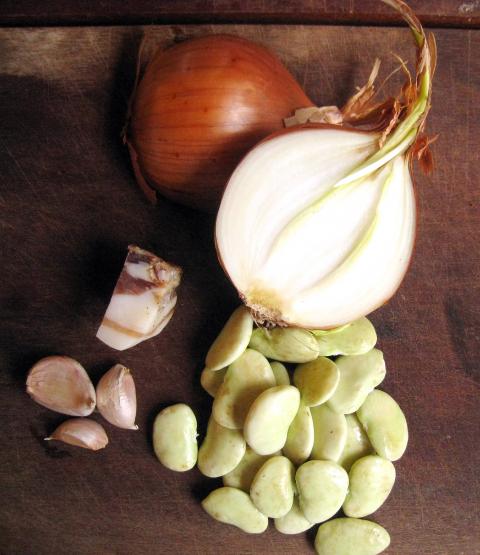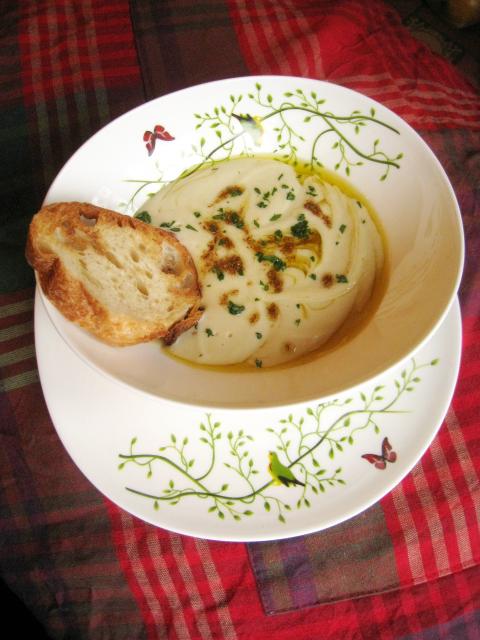Lima beans, large, pale green and kidney shaped, look distinctly appealing stacked in clear plastic bags, having come into season this last month. I discovered them last year, and was quick to buy some to make a dish that has already become a family favorite: lima bean soup (see recipe). I had never seen fresh lima beans before becoming a habitue of Taiwan’s traditional markets, and they were distinctly alien to the middle-class Australian diet of my youth. Beans in soup, or indeed beans of any kind (excluding canned baked beans for breakfast), were regarded as both “rustic” and “foreign,” but using lima beans has help spur my growing realization of how very good beans can be. For me at least, it has brought them into the realm of sophisticated cuisine, rather in the way of the gentrification, or even ennoblement, of the formerly humble French cassoulet.
Lima beans got their name from the large trade in these legumes during the Spanish viceroyalty of Peru, when the beans were widely exported to Europe and elsewhere in the Americas, their point of origin stamped on the crates as “Lima, Peru.” In some countries lima beans are also called “butter beans” because of their starchy yet buttery texture. In Taiwan, one of their most common names is emperor bean (皇帝豆) due to their large size and delicate flavor. While many local food Web sites laud the lima bean for its health giving properties, it is not something often found in conventional Taiwanese cuisine. Canned and dried beans can be relatively easily found and are now regularly used in western-style cuisine, but I was keen to find a dish that really brought out the subtle flavors and creamy texture of the fresh beans.
The most inescapable aspect from even the most cursory perusal of the Internet are the abundant, even overwhelming, claims for its nutritional and health-enhancing benefits. Any thorough rundown of all the claims made for it would fill pages, but it is worth noting that lima beans, like all legumes, are a good source of cholesterol-lowering fiber. In addition to lowering cholesterol, the high fiber content of lima beans prevents blood sugar levels from rising too rapidly after a meal, making these beans an especially good choice for individuals with diabetes, insulin resistance or hypoglycemia. Lima beans also contain insoluble fiber, which studies have shown help prevent constipation and digestive disorders like irritable bowel syndrome and diverticulosis. It also reduces the risk of heart attack, raises iron levels in the blood and is a great source of fat-free protein (making it particularly good red meat substitute for vegetarians). The list goes on and on. The only caveat on all this good news is that those with arthritis or kidney problems should only eat the bean in moderation due to its high potassium content.

Photo: Ian Bartholomew
Fresh lima beans are ridiculously easy to prepare, and simply need to be washed and cooked in water. They have a translucent skin, which may detach during cooking, but these are perfectly edible and nutritious. The cooking liquid used in preparing the beans can also be retained in most cases to minimize loss of highly-soluble potassium, which is an important element of the bean’s nutritional armory.
Lima Bean Soup with Cumin Oil
This is a rich, creamy winter soup that uses no cream, relying on the buttery texture of the beans to give it a smooth, velvety texture. It is quick to make and can serve as a meal in its own right, or a tempting opening to a multi-course banquet.

Photo: Ian Bartholomew
Recipe
(serves 4)
Ingredients
For the soup
300g fresh lima beans
400ml home-made vegetable or chicken stock
2 cloves garlic
40g salted pork or bacon (optional, but it does give the soup an added depth of flavor)
1 onion, roughly chopped
2 tbsp olive oil
Salt and pepper
For the garnish
2 tbsp olive oil
2 teaspoon cumin seed
Pinch salt
Parsley, finely chopped
Directions
1. Wash the beans and then cover with cold water by 5cm or more. Bring to a boil then simmer uncovered for 30 minutes.
2. Drain, reserving cooking liquid and set aside.
3. While the beans are cooking, put the onion, bacon and olive oil in a heavy-based saucepan and heat gently until the onions soften and become translucent. Add the garlic and cook for two or three more minutes.
4. Add the stock and cooking liquid. Bring to a boil then simmer for 20 minutes. Season with salt and pepper.
5. Add the beans and cook for a further 10 minutes.
6. Put in a blender (a powerful blender such as a Blendtec or Vitamix will produce a creamier, finer textured soup) and blitz until smooth. Adjust seasoning. The soup should pour like thick cream. If it is too much like a puree, just add a bit more stock to thin it.
7. Toast the cumin seeds in a dry fry pan over low heat until fragrant. The toasted seeds can be easily ground with a small pestle and mortar, though a spice grinder will save you some slight exertion.
8. Place the ground cumin in a small pan with the olive oil and a pinch of salt. Heat over low heat for two or three minutes. Remove from heat and set aside.
9. When ready to serve, drizzle the cumin oil on the soup, along with a generous sprinkle of chopped parsley. Serve the soup either warm or at room temperature with toasted French bread.

US President Donald Trump may have hoped for an impromptu talk with his old friend Kim Jong-un during a recent trip to Asia, but analysts say the increasingly emboldened North Korean despot had few good reasons to join the photo-op. Trump sent repeated overtures to Kim during his barnstorming tour of Asia, saying he was “100 percent” open to a meeting and even bucking decades of US policy by conceding that North Korea was “sort of a nuclear power.” But Pyongyang kept mum on the invitation, instead firing off missiles and sending its foreign minister to Russia and Belarus, with whom it

When Taiwan was battered by storms this summer, the only crumb of comfort I could take was knowing that some advice I’d drafted several weeks earlier had been correct. Regarding the Southern Cross-Island Highway (南橫公路), a spectacular high-elevation route connecting Taiwan’s southwest with the country’s southeast, I’d written: “The precarious existence of this road cannot be overstated; those hoping to drive or ride all the way across should have a backup plan.” As this article was going to press, the middle section of the highway, between Meishankou (梅山口) in Kaohsiung and Siangyang (向陽) in Taitung County, was still closed to outsiders

Many people noticed the flood of pro-China propaganda across a number of venues in recent weeks that looks like a coordinated assault on US Taiwan policy. It does look like an effort intended to influence the US before the meeting between US President Donald Trump and Chinese dictator Xi Jinping (習近平) over the weekend. Jennifer Kavanagh’s piece in the New York Times in September appears to be the opening strike of the current campaign. She followed up last week in the Lowy Interpreter, blaming the US for causing the PRC to escalate in the Philippines and Taiwan, saying that as

The Chinese Communist Party (CCP) has a dystopian, radical and dangerous conception of itself. Few are aware of this very fundamental difference between how they view power and how the rest of the world does. Even those of us who have lived in China sometimes fall back into the trap of viewing it through the lens of the power relationships common throughout the rest of the world, instead of understanding the CCP as it conceives of itself. Broadly speaking, the concepts of the people, race, culture, civilization, nation, government and religion are separate, though often overlapping and intertwined. A government